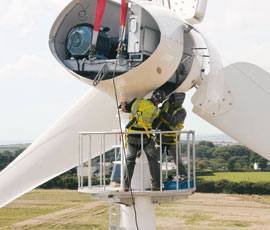FiTs announcement brings mixed blessings

Changes to Feed-in Tariffs are mostly good news for AD and wind installations, but small-scale wind projects will suffer, experts have warned.
After months of consultation, the Department of Energy and Climate Change announced on 20 July FiTs rates will drop as expected, but not until 1 December 2012, rather than 1 October as originally thought. This is good news as it will reduce the pressure on people rushing to complete projects this autumn, said surveyor and consultant Fisher German.
FiTs will fall from 25.4/p/kWh to 21p/kWh on wind projects up to 100kW and from 20.6p/kWh to 17.5p/kWh on projects between 100kW and 500kW.
On-farm projects typically fit into these bands, but much smaller wind turbines are frequently used.
This announcement comes as it was revealed that the weekly average of solar-panel installations has halved compared with the same time last year. This followed cuts to FiTs in April from 43p/kWh to 21p/kWh.
Export tariff rates have increased from 3.1p/kWh to 4.5p/kWh, which will benefit medium-sized projects, said Fisher German, but many smaller-scale wind projects are likely to become unviable.
“Unfortunately, wind projects in the 5kWh to 10kWh region will suffer as the confirmed drop in FiTs for these projects from 28p/kWh to 21p/kWh will make the vast majority of projects unviable, except on high wind-speed sites,” said Mark Newton, head of renewable energy at Fisher German.
An accreditation scheme will be put in place, the DECC also announced, allowing those developing renewables projects to benefit from the higher FiTs rates on their project before it is built, providing they have planning permission and a grid-connection offer.
Preliminary accreditation will be available for six months for solar PV, one year for anaerobic digestion and wind installations and two years for hydro schemes.
Chief adviser for renewable energy and climate change at the NFU, Dr Jonathan Scurlock said the downside to the announcement was that the projected level of deployment on AD did not match government targets of 100 AD installations a year.
“The government baseline budget is for no more than around 40 large AD plants a year, and only up to about 20 smaller plants,” he said.
“Although the government’s ambition has been raised from the original consultation proposals, this will still significantly constrain growth of a key renewable energy technology that can deliver multiple environmental benefits.”
| Technology | Band (kW) | Current generation tariffs (p/kWh) | Final tariffs from 1 Dec 2012 (p/kWh) |
|---|---|---|---|
| Wind | 1.5 | 35.8 | 21 |
| >1.5-15 | 28 | 21 | |
| >15-100 | 25.4 | 21 | |
| >100-500 | 20.6 | 17.5 | |
| >500-1,500 | 10.4 | 9.5 | |
| >1,500-5,000 | 4.9 | 4.48 | |
AD | 250 | 14.7 | 14.7 |
| >250-500 | 13.6 | 13.6 | |
| >500-5,000 | 9.9 | 8.96 |
